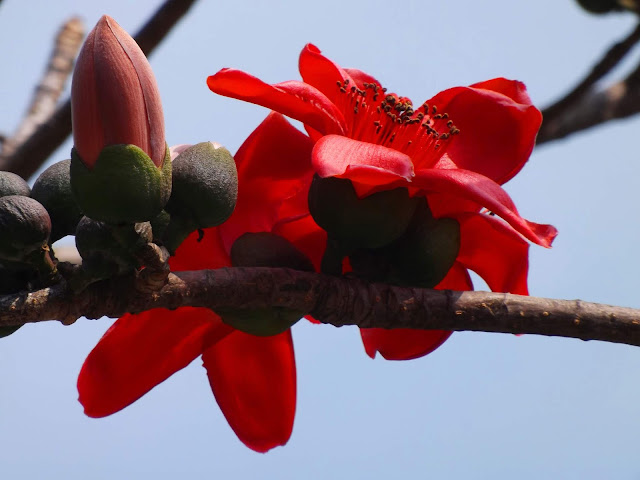Kanaidinga or Indian trumpet flower, Oroxylum indicum
Kanaidinga or Indian trumpet flower (Oroxylum indicum, family: Bignoniaceae) is a small-sized deciduous tree with ruddy violet stem, attaining a height of 8-10 m. Trunk and branches are glabrous. Bark is soft and thick, brown-colored. It is found almost all over the country including hilly forests of Chattogram division and Sylhet division and the shal forests of Bangladesh. It is also found in the Southeast regions of Asia.
Other names: Shona (Bang), Indian caper, Broken bones, Midnight horror (Eng); Kotombhar, Priyajeeb, Dirghabrintak, Pitapadap (Sans).
Leaves are compound, very large, 1.5 to 2 meters long. Interestingly, its leaves are not only bipinante but also tri-pinnate too. Because sometimes the third rachis holds 3 Leaflets. Leaflets lanceolate, 8-10 cm long and 2-7 cm wide, rounded or slightly cordate at the base, apex pointed, short petioled. New foliage appears on the tree at the end of winter.
Night-blooming flowers are bell-shaped, quite large, pale yellow, petals 5, which have a slight purple touch, are curved downwards; clustered on 60-160 cm long in erect terminal racemes. Corolla tube is purple. The flowers fall before daylight. These are stinking. Fowering occurs in autumn.
Fruit is capsule, very long, 30 to 65 cm, 5-8 cm wide; flat, sword-shaped, stays on branches for many days; many seeded. Propagation is caused by seeds and cuttings.
Root is used in diarrhoea, dysentery, jaundice and arthritis. The juice of raw fruits prevent flatulence and stomach ailments. These are also cooked and eaten as vegetables. Bark is tonic, analgesic and used in asthma. The bark is also used for dyeing and tanning somewhere in the Indian subcontinent. Trunk and branches are used as firewood.
Synonyms: Arthrophyllum ceylanicum, Arthrophyllum reticulatum, Bignonia indica, Bignonia lugubris, Bignonia pentandra, Bignonia quadripinnata, Bignonia tripinnata, Bignonia tuberculata, Calosanthes indica, Hippoxylon indica, Oroxylum flavum, Oroxylum indicum, Spathodea indica.
Other plants of Bignoniaceae family in the site






BC307EB953
ReplyDeletebeğeni satın al
Tiktok Takipçi Arttırma
Tiktok Takipçi Gönderme
Sanal Numara
Mobil Ödeme Takipçi